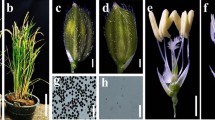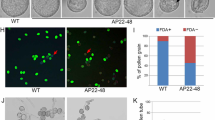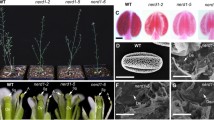Abstract
A male-sterile mutant of Arabidopsis thaliana was isolated by T-DNA tagging screening. Using transmission electron microscopy analysis, we revealed that the microspores of this mutant did not have normal thick primexine on the microspore at the tetrad stage. Instead, a moderately electron-dense layer formed around the microspores. Although microspores without normal primexine failed to form a proper reticulate exine pattern at later stages, sporopollenin was deposited and an exine-like hackly structure was observed on the microspores during the microspore stage. Thus, this mutant was named hackly microspore (hkm). It is speculated that the moderately electron-dense layer was primexine, which partially played its role in sporopollenin deposition onto the microspore. Cytological analysis revealed that the tapetum of the hkm mutant was significantly vacuolated, and that vacuolated tapetal cells crushed the microspores, resulting in the absence of pollen grains within the anther at anthesis. Single nucleotide polymorphism analysis demonstrated that the hkm mutation exists within the MS1 gene, which has been reportedly expressed within the tapetum. Our results suggest that the critical process of primexine formation is under sporophytic control .




Similar content being viewed by others
References
Aarts MGM, Hodge R, Kalantidis K, Florack D, Wilson ZA, Mulligan B, Stiekema WJ, Scott R, Pereira A (1997) The Arabidopsis MALE STERILITY 2 protein shares similarity with reductases in elongation/condensation complexes. Plant J 12:615–623
Ahlers H, Thom I, Lambert J, Kuckuk R, Wiermann R (1999) 1H NMR analysis of sporopollenin from Typha Angustifolia. Phytochemistry 50:1095–1098
Ariizumi T, Hatakeyama K, Hinata K, Sato S, Kato T, Tabata S, Toriyama K (2003) A novel male-sterile mutant of Arabidopsis thaliana, faceless pollen-1, produces pollen with a smooth surface and an acetolysis-sensitive exine. Plant Mol Biol 53:107–116
Ariizumi T, Hatakeyama K, Hinata K, Inatsugi R, Nishida I, Sato S, Kato T, Tabata S, Toriyama K (2004) Disruption of the novel plant protein NEF1 affects lipid accumulation in the plastids of the tapetum and exine formation of pollen, resulting in male sterility in Arabidopsis thaliana. Plant J 39:170–181
Fitqgerald MA, Knox RB (1995) Initiation of primexine in freeze-substituted microspores of Brassica campestris. Sex Plant Reprod 8:99–104
Ito T, Shinozaki K (2002) The male sterility1 gene of Arabidopsis, encoding a nuclear protein with a PHD-finger motif, is expressed in tapetal cells and is required for pollen maturation. Plant Cell Physiol 45:1285–1292
Meuter-Gerhards A, Riegart S, Wiermann R (1999) Studies on sporopollenin biosynthesis in Curcurbita maxima (DUCH)-II: the involvement of aliphatic metabolism. J Plant Physiol 154:431–436
Osthoff KS, Wiermann R (1987) Phenols as integrated compounds of sporopollenin from Pinus pollen. J Plant Physiol 131:5–15
Owen HA, Makaroff CA (1995) Ultrastructure of microsporogenesis and microgametogenesis in Arabidopsis thaliana (L.) Heynh. Ecotype Wassilewskija (Brassicaceae). Protoplasma 185:7–21
Paxson-Sowders DM, Owen HA, Makaroff CA (1997) A comparative ultrastructural analysis of exine pattern development in wild-type Arabidopsis and a mutant defective in pattern formation. Protoplasma 198:53–65
Paxson-Sowders DM, Dodrill CH, Owen HA, Makaroff CA (2001) DEX1, a novel plant protein is required for exine pattern formation during development in Arabidopsis. Plant Physiol 127:1739–1749
Piffanelli P, Ross JHE, Murphy DJ (1998) Biogenesis and function of the lipidic structures of pollen grains. Sex Plant Reprod 11:65–80
Sato Y, Nishio T (2003) Efficient detection of DNA polymorphism in cabbage and rice cultivars by PCR-RF-SSCP (PRS). Plant Cell Rep 21:276–281
Scott RJ (1994) Pollen exine: the sporopollenin enigma and the physics of pattern. In: Scott RJ, Stead MA (eds) Molecular and cellular aspects of plant reproduction. University Press, Cambridge, pp 49–81
Scott RJ, Hodge R, Paul W, Draper J (1991) The molecular biology of anther differentiation. Plant Sci 80:167–191
Scott RJ, Spielman M, Dickinson HG (2004) Stamen structure and function. Plant Cell 16:S46–S60
Sorensen AM, Krober S, Unte US, Huijser P, Dekker K, Saedler H (2003) The Arabidopsis ABORTED MICROSPORES (AMS) gene encodes a MYC class transcription factor. Plant J 33:413–423
Tsuchiya T,Toriyama K, Yoshikawa M, Ejiri S, Hinata K (1995) Tapetum-specific expression of the gene for an endo-β-1,3-glucanase causes male sterility in transgenic tobacco. Plant Cell Physiol 36:487–494
Wilmesmeier S, Wiermann R (1995) Influence of EPTC (A-ethyl-dipropyl-thiocarbamate) on the composition of surface waxes and sporopollenin structure in Zea mays. J Plant Physiol 146:22–28
Wilson ZA, Morroll AM, Dawson J, Swarup R, Tighe PJ (2001) The Arabidopsis MALE STERILITY1 (MS1) gene is a transcriptional regulator of male gametogenesis, with homology to the PHD-finger family of transcription factors. Plant J 28:27–39
Worall D, Hird DL, Hodge R, Paul W, Draper J, Scott R (1992) Premature dissolution of the microsporocyte callose wall causes male sterility in transgenic tobacco. Plant Cell 4:759–771
Zinkl GM, Zwiebel BI, Grier DG, Preuss D (1999) Pollen-stigma adhesion in Arabidopsis: a species-specific interaction mediated by lipophilic molecules in the pollen exine. Development 126:5431–5440
Acknowledgements
We are grateful to Dr. Takuya Ito and Dr. Kazuo Shinozaki for providing the ms1-8 mutant. We are grateful to Dr. Kara Johnson in the Department of Crop and Soil Science of Washington State University for critical reading of the manuscript. This work was supported by a grant-in-aid from the Ministry of Education, Culture, Sports, Science and 18 Technology of Japan and the Research for the Future Program of the Japan Society for the Promotion of Science (JSPS=RFTF00L01606). T.A. is a recipient of a Research Fellowship for young scientists from JSPS.
Author information
Authors and Affiliations
Corresponding author
Rights and permissions
About this article
Cite this article
Ariizumi, T., Hatakeyama, K., Hinata, K. et al. The HKM gene, which is identical to the MS1 gene of Arabidopsis thaliana, is essential for primexine formation and exine pattern formation. Sex Plant Reprod 18, 1–7 (2005). https://doi.org/10.1007/s00497-005-0242-3
Received:
Accepted:
Published:
Issue Date:
DOI: https://doi.org/10.1007/s00497-005-0242-3




